The Great Hercules Cluster is on everyone's observing menu this summer. But there's lots more to see within a stone's throw of this grand object — like 20 galaxies!
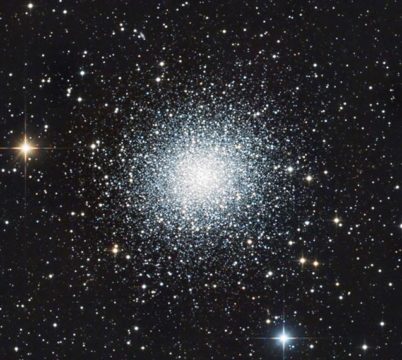
Stephan Nicolas
It's safe to say that most amateur astronomers consider the Great Hercules Cluster the finest globular of the northern sky. Few sights make hungry eyes happier than dialing up this incredibly rich cluster with an 8-inch or larger telescope. Stars spill out from the overcrowded core like gorilla arms.
Everything about this globular makes you crave another look the next clear night. Because it shines at magnitude 5.8, you can see it with the naked eye from a dark sky. Binoculars reveal an inviting, blurry glow with a brighter center. A 6-inch telescope at a magnification of 125× resolves the cluster's outer halo into a flurry of faint stars that come and go according to the mood of the atmosphere. But if you've ever lusted for a larger instrument in hopes of seeing more in your deep-sky objects, globular clusters remain the best reason to make the investment. Especially our friend in Hercules.
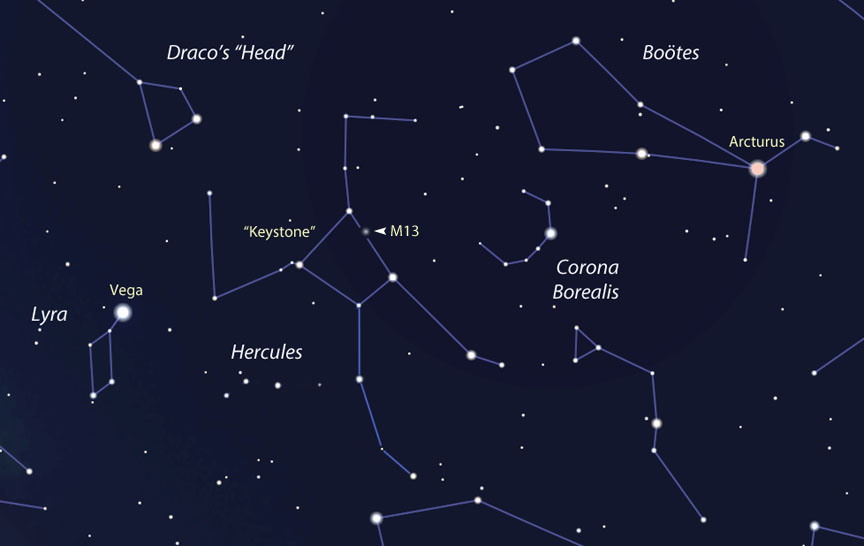
Stellarium
Hundreds and hundreds of stars are resolved at 142× in my 15-inch. Suns pile hand over fist in the dense core, resembling a mass of young tadpoles in a pond. I can resolve individual stars right across the core, but tens of thousands of fainter stars behind these merge into a quivering mass of luminosity forever on the verge of resolution.
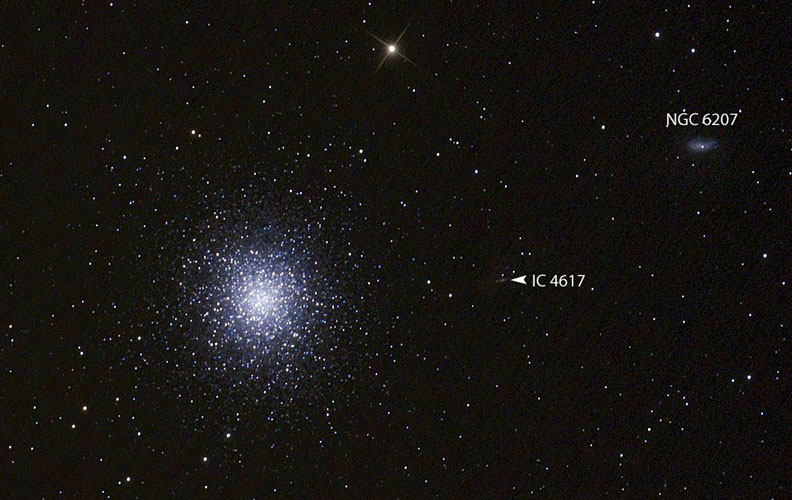
Lukáš Kalista
Even at my lowest magnification of 64× I see six arcs of stars unfurling from either side of the core cluster toward the southwest like hair blown by a steady northeast wind. The symmetry is striking and brings other images to mind: crab, tardigrade, multi-armed alien. The 19th-century astronomer John Herschel described them as "hairy looking, curvilinear branches."
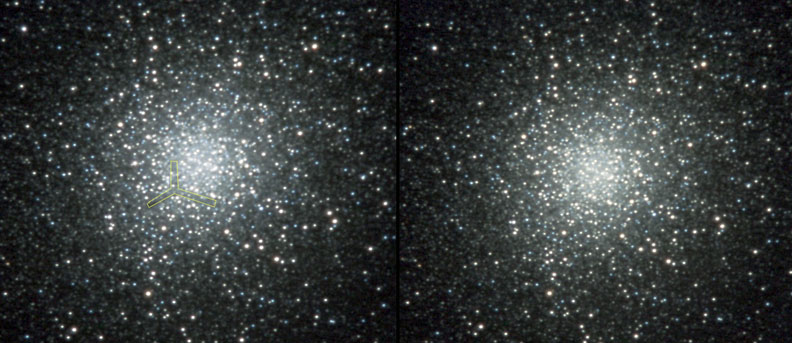
Dr. Charles Hakes / Fort Lewis College Observatory
Within the cluster's southeastern side, owners of 8-inch and larger telescopes using powers of 200× and up can look for the famous "propeller," a Y-shaped feature made of three narrow, dark lanes at 120° angles to one another. After studying photographs and seeing the vacuity with my own eyes, I suspect its shape results from a lack of brighter cluster members in the propeller area, enhanced by the neat row of stars along one edge of the western spoke. Pattern-seeking creatures that we are, our brains combine these fragments to make a propeller. The curious feature was first noted in about 1850 by Bindon Stoney, an astronomer working at Birr Castle in Ireland, home to Lord Rosse's famous 72-inch reflecting telescope.
After supping on the Hercules Globular, owners of larger scopes can nibble on fainter sights set within a few degrees of the cluster. I spent an entire observing session here and found 20 galaxies before the rising Moon forced me to quit. The entire region is littered with little fuzzy blobs, most of them faint with the exception of NGC 6207, a standout at magnitude 11.4. Through a 6-inch scope it's a dim, north-south elongated oval haze just 20′ northeast of M13. In my 15-inch at 245× the galaxy's tightly wrapped spiral arms give the disk an uneven texture. What looks like a bright stellar nucleus is actually a foreground star.
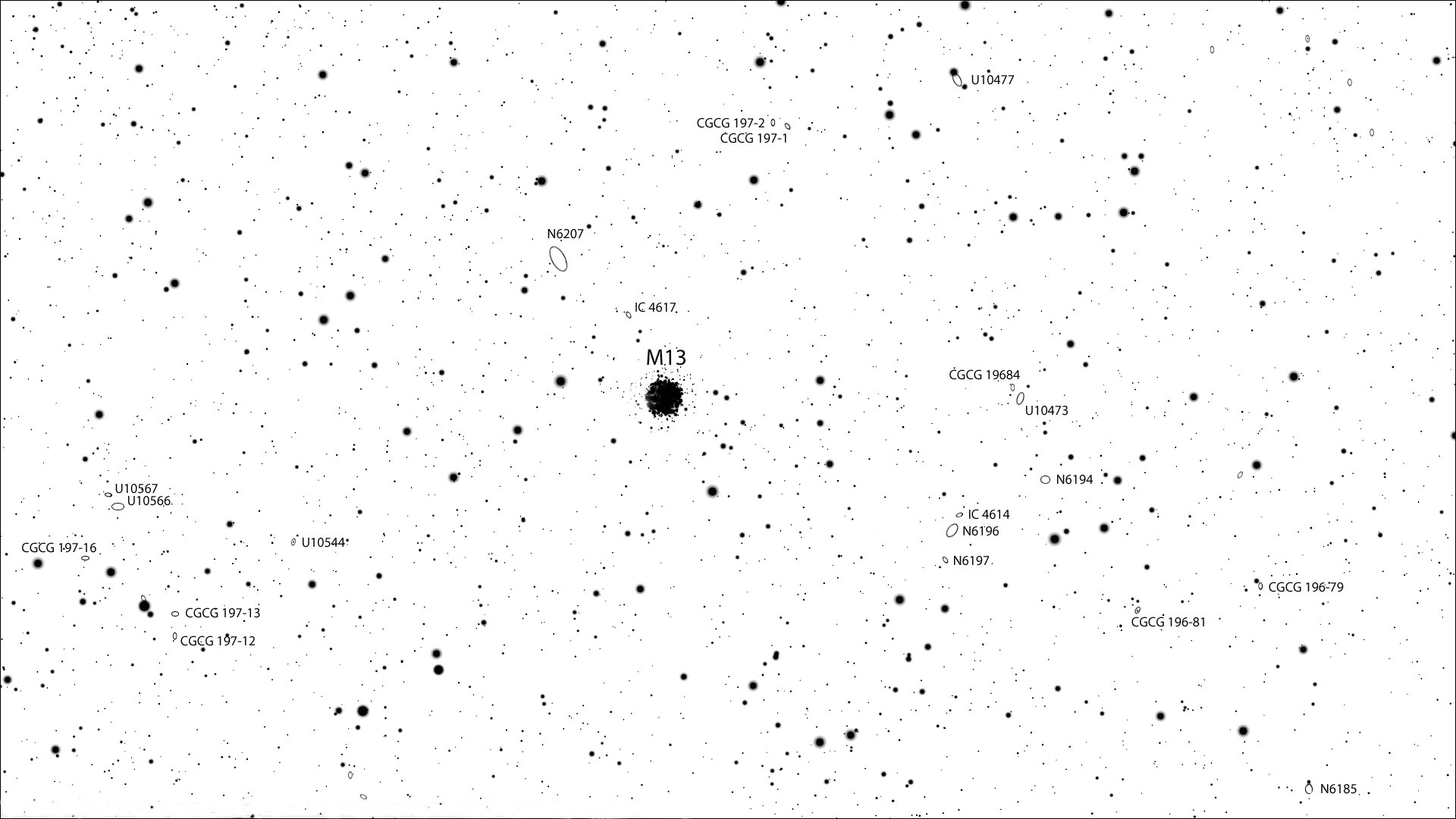
Stellarium with additions by the author
The other 19 galaxies around M13 present degrees of challenge. Generally, the NGC-numbered objects are larger and brighter than those with UGC (Uppsala General Catalog) and CGCG (Catalog of Galaxies and Clusters of Galaxies) prefixes. I've provided a map that shows the location of each with stars plotted to magnitude 15. Just find M13 and you're on your way! I started at NGC 6207, then turned west to the NGC section before returning to M13 and heading east into CGCG territory.
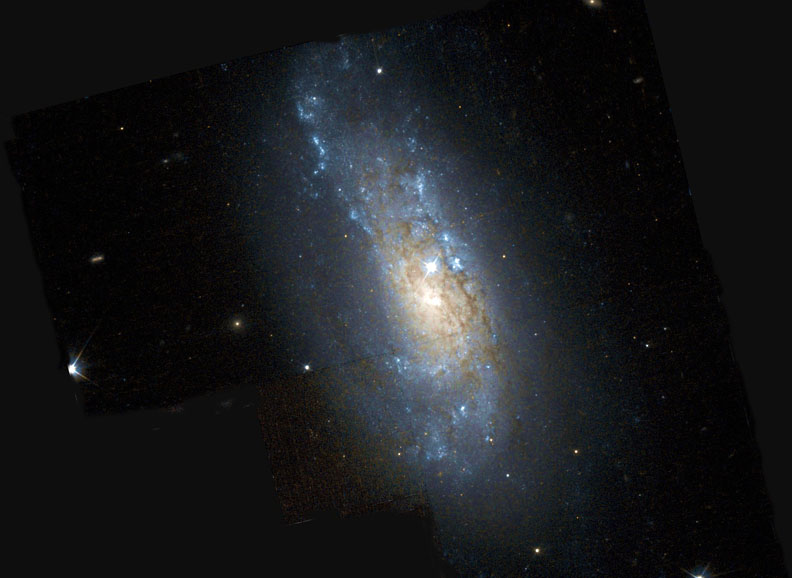
NASA / ESA / HST
When beginning your galactic adventure use a medium magnification (142×) to start. Once you know exactly where you are in the field of view, increase the power to 245× and stick with it. Higher magnifications show small, faint objects like galaxies much better. Besides expanding these small objects into something big enough to register with your eye, high magnification darkens the sky background for increased contrast.
During my extragalactic expedition, I'd occasionally lose my place or an object would drift out the field when I'd step away to check a chart. Finding my place again was never a problem: with M13 nearby you can never really get lost.
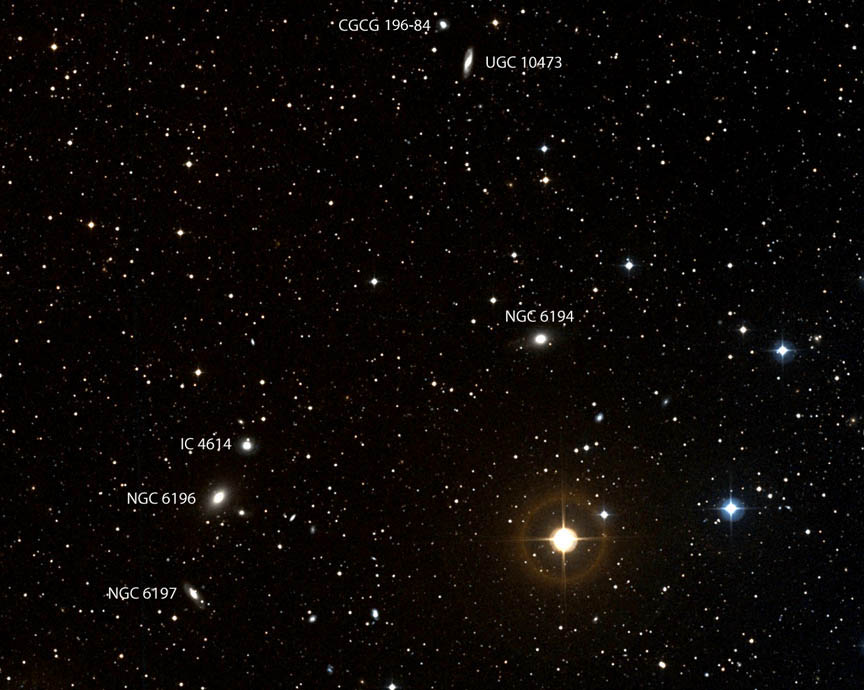
DSS2
Following are observing notes made with my 15-inch Dobsonian. Most are brief because many of the galaxies were only smudges. Take the scary-looking magnitudes with a grain of salt — some of the objects appeared brighter than listed. For more information on many of the galaxies (plus photos) go to DSO Browser and perform a Find Object search.
- IC 4617 (magnitude 15.2) — Nothing like starting out the hard way! A tiny dab of haze touching a 14th-magnitude star. Visible only with averted vision in moments of good seeing.
- NGC 6197 (14.6) — Small, quite diffuse, slightly brighter core. In a compact trio with NGC 6196 and IC 4614.
- NGC 6196 (12.9) — Dare I call this bright? Easy object, 2′ across, elongated north-south with a stellar nucleus.
- IC 4614 (14.3) — Round, faint, diffuse. Similar to NGC 6197.
- NGC 6194 (13.8) — Easy object about 1′ across, brighter toward the center with an ~14.5-magnitude stellar nucleus.
- UGC 10473 (13.9) — Dim but not difficult. Elongated north-south, 1.5′ across.
- CGCG 196-84 (15.6) — Very faint, small puff northeast of UGC 10473. Averted vision and patience required! What's the fun of observing if you don't suffer a little? Every time you push your scope the limit, you expand your sense of sight.
- CGCG 196-81 (15.6) — Dim, small but easy to spot with averted vision. Slight brighter center. Listed magnitude seems too faint.
- CGCG 196-79 (15.7) — Very faint. A diffuse, misty patch.
- NGC 6185 (13.4) — Yay! Another bright one. Dense little blob with a faint stellar nucleus. Touches a 12th-magnitude star to north.
- CGCG 197-2 (14.8) — Small, round fuzzball brighter and easier to see than its neighbor, CGCG 197-1.
- CGCG 197-1 (15.4) — Faint, quite small.
- UGC 10477 (15.2) — Galaxy positioned between 9.5- and 10.5-magnitude stars and tricky to see. Dim, diffuse haze visible with patience and averted vision.
- UGC 10544 (15.3) — Faint but easy with averted vision. Slightly brighter center with a possible very faint stellar nucleus.
- CGCG 197-10 (15.7) — Very small but dense little glow touching a 13.5-magnitude star. Seems brighter than listed magnitude.
- UGC 10567 (15.3) — Obvious puff of milky light brighter and a little larger than its neighbor, UGC 10566 2′ to the southwest.
- UGC 10566 (15.1) — Quite faint but visible OK with averted vision.
- CGCG 197-13 (15.2) — Small, round and easy with averted vision. Close to a magnitude-6.5 star. Forms a right triangle with neighboring CGCG 197-12 and the star.
- CGCG 197-12 (15.4) — Tiny, round bit of haze with a faint stellar nucleus. Not difficult with averted vision.
After you're finished observing all these fainties, take another look at M13 to refresh and happify your eyes. Know that this cluster, removed to any one of these galaxies, would be utterly invisible in all but the largest telescopes. Now sleep well.
 0
0








Comments
You must be logged in to post a comment.